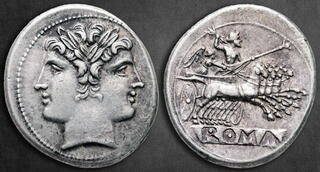Lot description:
Anonymous circa 225-214 BC. Uncertain mint
Quadrigatus AR
24 mm, 6,70 g
Laureate head of Janus / ROMA (incuse on raised tablet) Jupiter, hurling thunderbolt with his right hand and holding scepter in his left, in quadriga to right driven by Victory standing beside him. Crawford 29/3. RBW 63. Sydenham 64.
Beautifully toned and very well centered, dies of beautiful style, Near Extremely Fine.
Crawford 29/3; RBW 63; Sydenham 64.
The Quadrigatus coin, a significant numismatic artifact from the Roman Republic, offers a window into the religious and cultural milieu of ancient Rome. Minted around the 3rd century BC, this coin is notable for its intricate design and the rich symbolism it carries, reflecting the religious beliefs and societal values of early Rome. On the obverse of the Quadrigatus is a representation of Janus, the Roman god of beginnings, gates, transitions, time, duality, doorways, passages, and endings. Janus is uniquely depicted with two faces, symbolizing his ability to see both the past and the future, a representation of his omniscient nature. This imagery was particularly fitting for a coin, an object that would pass through countless hands, witnessing countless transactions throughout its lifetime. The reverse of the coin is equally fascinating, featuring Jupiter, the king of the gods, and Victoria, the personification of victory, riding in a quadriga, a four-horse chariot. This scene is not just a display of divine power but also a symbol of triumph and success. Jupiter, with his commanding presence, signifies strength and authority, while Victoria represents the glory of victory, an important concept in a Republic often engaged in territorial expansions and military campaigns.
Below this dynamic scene, the inscription "ROMA" is incused on a tablet. This not only signifies the coin's place of origin but also serves as a statement of civic pride and identity. In a time when Rome was expanding its influence across the Mediterranean, such coins would have served as ambassadors of Roman culture and power, spreading the city's name far and wide.
The Quadrigatus holds a special place in the history of Roman coinage. Its design elements - the Janus head, the depiction of Jupiter and Victoria, and the proud inscription of "ROMA" - all convey the values, beliefs, and aspirations of the Roman Republic. As a medium of commerce, it facilitated economic transactions; as a work of art, it communicated the essence of Roman religion and culture; and as a historical artifact, it offers us insights into the world of ancient Rome, its gods, and its people
Starting price: 1500 EUR |  |